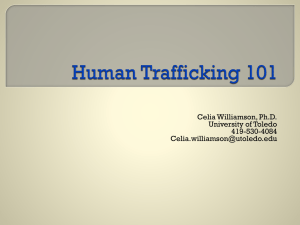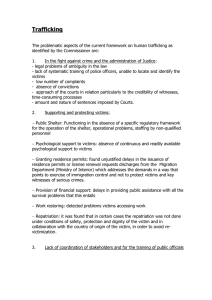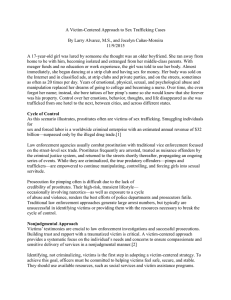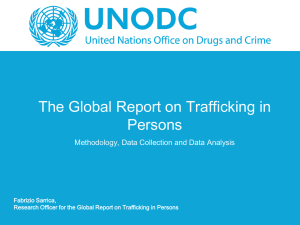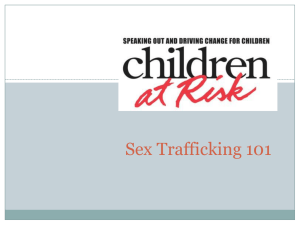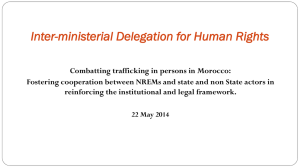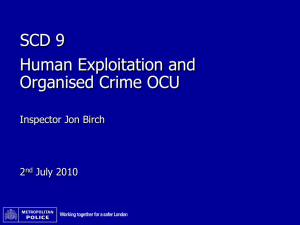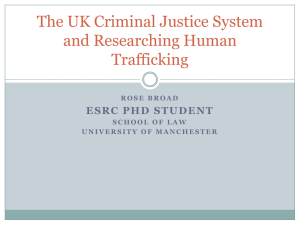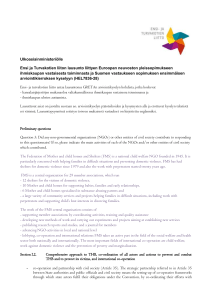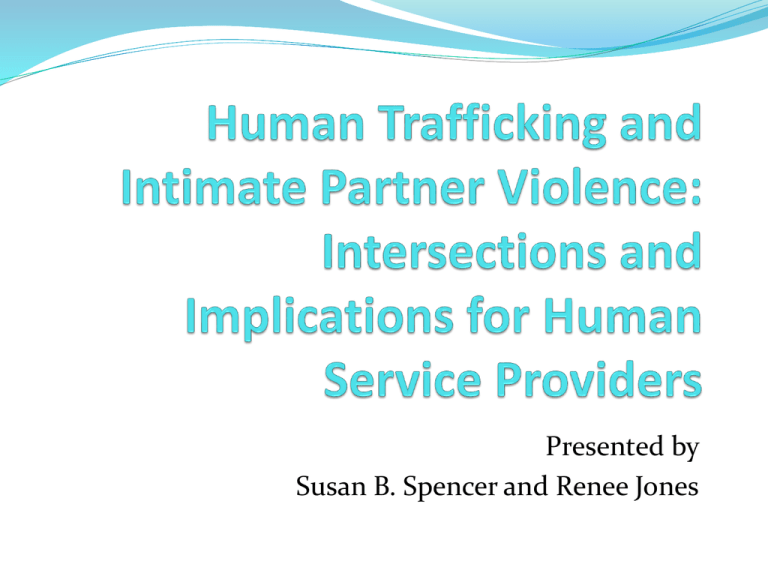
Presented by
Susan B. Spencer and Renee Jones
Susan Spencer’s presentation was
supported by contract
#HHSP233200900774P from the Office
on Woman’s Health. The content of this
presentation is solely the responsibility
of the presenter(s) and does not
represent the official views of OWH.
A pattern of coercive behaviors exerted by an
intimate partner over another with the goal of
establishing and maintaining power and control.
No matter what gender or sexual orientation the
victim or perpetrator may identify themselves as,
control and abuse are the common characteristic that
defines the relationship as violent
1 in 3 women experience some form of intimate
partner violence in given year
Human Trafficking Is…
A form of modern-day slavery where people profit from the
control and exploitation of others. As defined under U.S.
federal law, victims of human trafficking include children
involved in the sex trade, adults age 18 or over who are
coerced or deceived into commercial sex acts, and anyone
forced into different forms of "labor or services," such as
domestic workers held in a home, or farm-workers forced to
labor against their will. The factors that each of these
situations have in common are elements of force, fraud, or
coercion that are used to control people. Then, that control
is tied to inducing someone into commercial sex acts, or
labor or services.
Using Male Privilege (relationship)
Making all the big decisions.
Acting like "Master of the Castle".
Using Economic Abuse
Preventing you from getting or keeping
a job.
Making you ask for money.
Being the one to define men's and
women's roles.
Treating you like a servant.
Taking your money.
Not letting you know about or have
access to family income.
Giving you an allowance
Using Coercion, Threats and Physical Violence
Making and/or carrying out threats to do
something to hurt you.
Bruises, scars and other signs of
physical abuse and torture
Sex-industry victims often beaten in
areas that will not damage their
outward appearance, like lower back
•Threatening to "out" you.
Threatening to leave you, to commit
suicide, to report you to Welfare
authorities.
Making you do illegal things.
HIV and DV/IPV
Black women are victims
of DV at a rate 35%
higher than white
women
DV most common
among those 16-24yo
High rate of poverty and
homelessness amongst
DV victims
AIDS is the leading
cause of death for
African American
women in the US
Highest prevalence of
new HIV infection is
among youth 13-24yo
Highest prevalence of
HIV/AIDS among low
SES populations
Abusive partners:
May use sexual assault as a form of control
May refuse birth control, condoms
Frequently engage in sex outside the relationship,
putting themselves at high risk of STD’s, including
HIV
Giving an STD to a partner intentionally is another form
of power and control
http://www.opdv.state.ny.us/health_humsvc/health/hiv.html
Women who are abused:
Have difficulty accessing services, including health
care and may have:
Worsened overall health
Results in immune system being stressed
Difficulty in getting STD and HIV testing
Diagnosed at advanced stages rather than early,
so harder to treat
Difficulty assessing their own risk?
New Diagnosis and Risks of
Disclosure
Risk of violence directly after an HIV disclosure or
increased severity over long period of time.
Partner may hide meds or keep victim from getting
medical care.
Risk of partner “outing” victim for more power and
control and increased isolation
Emotional abuse may increase likelihood that
victim will stay. Ie: “No one else would ever want
you now.
A Positive Woman in a Violent Relationship
Many + women report that even though a partner is
abusive, if they accept the HIV, then that makes the
violence somehow more acceptable.
Risk of being outed if they leave is very real.
May feel guilt if they think they infected the abusive
partner.
Screening for Domestic Violence
“Do you ever feel unsafe at home?”
“Do you ever feel afraid of someone close to you?
“Have you ever been pushed, grabbed, slapped,
choked or kicked by an intimate partner?
Have you or your children ever been threatened?
“Has anyone ever stalked, followed or monitored
you?”
Have you ever been or are you currently concerned
about harming your partner or someone close to
you?”
HIV Testing for Victims of Violence
Pros of Testing
STD/HIV Testing is
sometimes only way
victims can protect
themselves sexually
Knowing can alleviate
some stress
Giving victims back
power over their bodies
Considerations in not
testing
Isolation—lack of
support if positive result
Emotional stability,
access to victim if
suicidal
Can make safe disclosure
decisions
Know Human Trafficking
Human trafficking is code for slavery –
involuntary servitude, debt bondage or
peonage. Thousands of Northeast Ohio
children, women and men are enslaved
to commercial sex or forced labor
annually. Trafficking violates human
rights and is
a stand-alone felony in Ohio.
Founded in 2002, the Renee Jones
Empowerment Center (RJEC) is the
only Northeast Ohio 501(c)(3) agency
committed to providing life coaching
and aftercare services to those with the
courage to break the human trafficking
cycle.
RJEC shines light on the dark side of
humankind and offers a comprehensive
approach to getting lives back on track.
Characteristics and Traits of Traffickers
•Traffickers can be men or women.
•Recruiters are often selected for their ability to quickly
establish trust.
•Female traffickers are often used to recruit victims who would
quickly perceive them as trustworthy and credible.
•Some traffickers are victims themselves.
•Traffickers can be of any nationality, especially now that it has
become a global problem
•Traffickers can be any one from a child to an elderly person.
•Some traffickers are willing to victimize their own families.
•Extreme poverty can create a trafficker.
•They can be educated or not.
•Some traffickers have professional occupations. A doctor or a
lawyer and so on.
Who Might be a Trafficker?
Some examples of those involved in trafficking include:
•Pimps
•Intimate partners/family members
•Gangs and criminal network
•Brothel and massage parlor owners and managers
•Growers and crew-leaders in agriculture
•Labor brokers
•Employers of domestic servants
•Small business owners and managers
•Large factory owners and corporations
Screening For Victims of Human Trafficking
As with domestic violence victims,
if you think a patient is a victim of
trafficking, you do not want to
begin by asking directly if the
person has been beaten or held
against his/her will. Instead, you
want to start at the edges of his/her
experience.
And if possible, you should enlist
the help of a staff member who
speaks the patient’s language and
understands the patient’s culture,
keeping in mind that any
questioning should be done
confidentially.
You should screen interpreters to
ensure they do not know the victim
or the traffickers and do not
otherwise have a conflict of
interest.
Before you ask the person any
sensitive questions, try to get the
person alone if they came to you
accompanied by someone who
could be a trafficker posing as a
spouse, other family member or
employer. However, when
requesting time alone, you should
do so in a manner that does not
raise suspicions.
Suggested Screening Questions:
•Can you leave your job or situation if you want?
•Can you come and go as you please?
•Have you been threatened if you try to leave?
•Have you been physically harmed in any way?
•What are your working or living conditions like?
•Where do you sleep and eat?
•Do you sleep in a bed, on a cot or on the floor?
•Have you ever been deprived of food, water, sleep or medical care?
•Do you have to ask permission to eat, sleep or go to the bathroom?
•Are there locks on your doors and windows so you cannot get out?
•Has anyone threatened your family?
•Has your identification or documentation been taken from you?
•Is anyone forcing you to do anything that you do not want to
•Do not collect more information than you need! In depth interviews
with the potential victim should be conducted by mental health
professionals, law enforcement professionals or legal experts. Multiple
interviews may confuse and/or re-traumatize victims and may put you,
as a service provider, at risk of being subpoenaed as a witness.
•If you think you have come in contact with a victim of human
trafficking, call the National Human Trafficking Resource Center at
1.888.3737.888. This hotline will help you determine if you have
encountered victims of human trafficking, will identify local resources
available in your community to help victims, and will help you
coordinate with local social service organizations to help protect and
serve victims so they can begin the process of restoring their lives.
Street Outreach Model
Street Outreach:
In an effort to reach out to sex
trafficking victims, The RJEC
Project Red Cord Response Team
conducts bi- weekly outreach with
women who are being sexually
exploited on the streets of
Cleveland. A dedicated team of
trained volunteers and staff
venture out to the street to meet
women being prostituted. We offer
these women love, encouragement,
and a source of hope by
distributing Red Bags of Hope,
filled with handwritten notes of
hope, hygiene products, snacks,
and other gifts, as well as
emergency hotline cards and
information about our support
programs & services.
Access to emergency shelter
Basic survival tools (clothing, food,
hygiene supplies)
Advocacy
Referrals to needed medical services
Referrals to sexual assault and crisis
rape relief counseling
Referrals to drug and alcohol
counseling
Individual assessments and case
managements
Relationship building with trustworthy
adults
Coordination with community partners
and law enforcement
Assistance in finding housing and
employment
Referrals to family counseling
Educational and skill-building
opportunities
Follow-up support
QUESTIONS?
Susan B. Spencer, LCSW
Consultant
Susan B. Spencer, Inc.
8016 Flourtown Ave
Wyndmoor, PA 19038
215-233-5373
sbspencer@comcast.net
Renee Jones, President &
CEO
Renee Jones Empowerment
Center
1340 West 65th Street Front
Cleveland, OH 44102
216-651-9601
www.rjecempower.org

